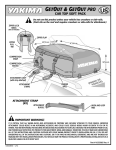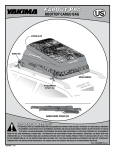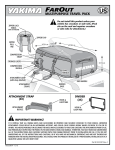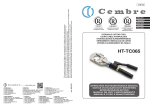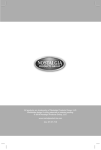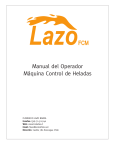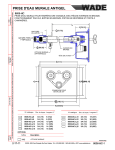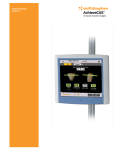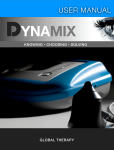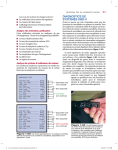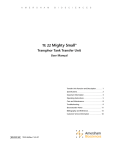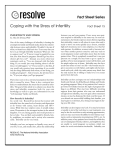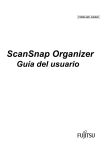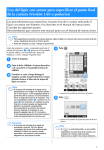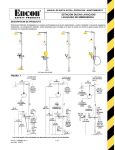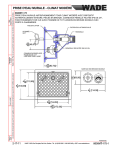Download GETOUT & GETOUT PRO
Transcript
GetOut & GetOut pro ROOFTOP CARGO BAG ZIPPER FLAP 31”/79 cm 43”/109 cm ATTACHMENT LOOPs 18”/46 cm Hook (x4) grab handle COMPRESSION STRAP (x4) COMPRESSION buckle (x4) ATTACHMENT STRAP (x4) OF NT LE) O (FR EHIC V Naked roof STRAP (2X) IMPORTANT WARNING IT IS CRITICAL THAT ALL YAKIMA RACKS AND ACCESSORIES BE PROPERLY AND SECURELY ATTACHED TO YOUR VEHICLE. IMPROPER ATTACHMENT COULD RESULT IN AN AUTOMOBILE ACCIDENT, AND COULD CAUSE SERIOUS BODILY INJURY OR DEATH TO YOU OR TO OTHERS. YOU ARE RESPONSIBLE FOR SECURING THE RACKS AND ACCESSORIES TO YOUR CAR, CHECKING THE ATTACHMENTS PRIOR TO USE, AND PERIODICALLY INSPECTING THE PRODUCTS FOR ADJUSTMENT, WEAR, AND DAMAGE. THEREFORE, YOU MUST READ AND UNDERSTAND ALL OF THE INSTRUCTIONS AND CAUTIONS SUPPLIED WITH YOUR YAKIMA PRODUCT PRIOR TO INSTALLATION OR USE. IF YOU DO NOT UNDERSTAND ALL OF THE INSTRUCTIONS AND CAUTIONS, OR IF YOU HAVE NO MECHANICAL EXPERIENCE AND ARE NOT THOROUGHLY FAMILIAR WITH THE INSTALLATION PROCEDURES, YOU SHOULD HAVE THE PRODUCT INSTALLED BY A PROFESSIONAL INSTALLER. Part #1033577 Rev. B 1033577B - 1/12 clear away dirt and debris from car’s roof. a Unfold the BAG. • Completely unzip the zipper. • Keep the bag closed. Select correct Bag position on your car’s roof (for installation without roof rack proceed to step 3b). CROSSBARS: SIDE-RAILS: In a BASKET: All 4 straps should be attached to the crossbars or towers (2 front, 2 rear). Straps attach to either side of the center post. Install front straps to front of basket, and rear straps to rear of basket. front of car front of car front of car INSTALL the bag between the rails or bars, NOT ABOVE THE BARS! IMPORTANT! NEVER INSTALL bag SIDEWAYS on vehicle— and— the top flap must unfold towards the front of the vehicle! b For installation on a naked roof (installation on vehicle with no rack system). Hooks may be inside, or outside car depending on vehicle size. 1033577B - 2/12 • Set bag on car. • Attach roof strap to one hook. • Do not route strap through door frame. • Thread roof strap through open car doors. • Attach to other hook. • Pull hook straps and/or roof straps • Tighten to secure bag. • Secure strap ends. • REPEAT FOR REAR STRAP. secure each strap to the racks. • Pull the strap ends to tighten the BAG to the racks. • Tuck the end of the strap back into the buckle to prevent the strap from loosening. • Secure strap ends with hook and loop fastener tabs. Always use the hook and loop tabs to secure surplus strap. open the BAG. Fold back the unzipped top and gently rest the flap on the windshield. The top must unfold towards the front of the vehicle! Load your gear. Do not exceed the capacity of your vehicle’s roof. Refer to your vehicle owner's manual for limitations. Distribute the contents evenly. DO NOT over-stuff the BAG! Close the bag. • Replace the top cover flap. • Close the zipper completely. If there is any resistance, check for overstuffing. CONNECT COMPRESSION STRAP BUCKLES. 1033577B - 3/12 • Tighten all four compression straps. • Pull strap ends against bag contents. • Align zippers at the center-back. Before driving away Check the Load! Pull and push the loaded bag. • Bag must be closed and attached to crossbars or siderails. • Check straps, buckles, and zipper before traveling. • Keep straps and bag from making contact with sharp metal edges. • If there is strap movement, tighten where needed. • Check the straps as you travel and tighten if necessary! WARNINGS TRAVEL WARNING You must tighten all straps after extended travel, and periodically during travel. Failure to check straps before and during travel can result in property damage, personal injury or death. • Do not use in severe winds. • Position bag to minimize wind loads under bag. • 75 mph (120 km/h) maximum speed. • Bag should be straight, never crooked. • Not for use with fragile, sharp, or heavy objects. • Remove bag before driving into garages or under low hanging objects. • Do not drive with unloaded bag. WEIGHT LIMITS Rack System (if appropriate) GetOut 4.1 lbs. / 1.9 kg GetOut Pro 7.2 lbs. / 3.3 kg = Contents Not more than 100 lbs. (45 kg) unless otherwise noted. OR the capacity of your roof as stated by the vehicle manufacturer. If this information is not available, DO NOT USE THIS PRODUCT. Do not leave your loaded BAG on the vehicle unattended. A closed zipper is not theft-proof. Storing the BAG PACK USAGE • Do not drive off-road. • Do not install onto trailers, campers, RVs unless a rack is installed. Although this product has padding, it will not prevent dents caused by over loading, under securing, or off-road driving. • Replace any straps that appear worn or frayed. • Remove bag before entering an automatic car wash. • Do not over stuff bag. • Do not leave the empty bag mounted to the vehicle. • Securing an empty bag to a moving vehicle could cause damage to the vehicle roof. • Always clean the bag after travel using a damp sponge with mild detergent containing no additives (such as alcohol, chlorine or ammonia) and air dry completely. • Once bag is dry, it can be rolled and stored. • Store out of direct sunlight and harsh weather. When fully loaded, it is recommended to get assistance removing bag from roof to avoid personal injury, or damage to the vehicle. Weather resistance • Always encase anything that must remain dry inside water-proof material before loading into the pack. • Keep zipper flap flat during travel. • When using the Naked Roof Strap wicking of moisture into the car may occur in very wet conditions. 1033577B - 4/12 Maintenance Use a damp sponge with mild detergent containing no additives (such as alcohol, chlorine or ammonia) to clean your bag. Air dry completely. K EE P T HESE I N S T R U C T I O N S GetOut & GetOut pro SAC À CHARGER SUR LE TOIT RABAT DE GLISSIÈRE 31”/79 cm 43”/109 cm PASSANT D’ARRIMAGE 18”/46 cm CROCHET (x4) POIGNÉE SANGLE DE COMPRESSION (x4) BOUCLE DE COMPRESSION (x4) SANGLE D’ARRIMAGE (x4) U T D E) N A L (AV HICU VÉ SANGLE POUR TOIT NU (x 2) AVERTISSEMENT IMPORTANT: IL EST IMPÉRATIF QUE LES PORTE-BAGAGES ET LES ACCESSOIRES YAKIMA SOIENT CORRECTEMENT ET SOLIDEMENT FIXÉS AU VÉHICULE. UN MONTAGE MAL RÉALISÉ POURRAIT PROVOQUER UN ACCIDENT D’AUTOMOBILE, QUI POURRAIT ENTRAÎNER DES BLESSURES GRAVES OU MÊME LA MORT, À VOUS OU À D’AUTRES PERSONNES. VOUS ÊTES RESPONSABLE DE L’INSTALLATION DU PORTE-BAGAGES ET DES ACCESSOIRES SUR VOTRE VÉHICULE, D’EN VÉRIFIER LA SOLIDITÉ AVANT DE PRENDRE LA ROUTE ET DE LES INSPECTER RÉGULIÈREMENT POUR EN CONTRÔLER L’ÉTAT, L’AJUSTEMENT ET L’USURE. VOUS DEVEZ DONC LIRE ATTENTIVEMENT TOUTES LES INSTRUCTIONS ET TOUS LES AVERTISSEMENTS ACCOMPAGNANT VOTRE PRODUIT YAKIMA AVANT DE L’INSTALLER ET DE L’UTILISER. SI VOUS NE COMPRENEZ PAS TOUTES LES INSTRUCTIONS ET TOUS LES AVERTISSEMENTS, OU SI VOUS N’AVEZ PAS DE COMPÉTENCES EN MÉCANIQUE ET NE COMPRENEZ PAS PARFAITEMENT LA MÉTHODE DE MONTAGE, VOUS DEVRIEZ FAIRE INSTALLER LE PRODUIT PAR UN PROFESSIONNEL. 1033577B - 5/12 BIEN ESSUYER LE TOIT DU VÉHICULE. a DÉROULER LE SAC. • Ouvrir la glissière complètement. • Garder le sac fermé. CHOISIR LA POSITION DU SAC CONVENANT AU TOIT DU VÉHICULE (S'IL N'Y A PAS DE PORTE-BAGAGE SUR LE TOIT, PASSER À L'OPÉRATION 3b). BARRES TRANSVERSALES : LONGERONS : DANS UN PANIER : Arrimer les 4 sangles aux barres transversales ou à leurs pieds (2 devant, 2 derrière) Arrimer les sangles de part et d’autre du support central. Arrimer les sangles avant à l’avant du panier et les sangles arrière à l’arrière du panier. avant du véhicule avant du véhicule avant du véhicule POSER LE SAC ENTRE LES LONGERONS OU LES BARRES, PAS PAR-DESSUS DES BARRES ! IMPORTANT ! NE JAMAIS MONTER LE SAC EN TRAVERS du véhicule — ET — le dessus du sac doit se rabattre vers l’avant du véhicule ! b ARRIMAGE SUR UN TOIT NU (POSE SUR UN VÉHICULE SANS PORTE-BAGAGE). Les crochets pourront se trouver à l'intérieur ou à l'extérieur, selon la taille du véhicule. 1033577B - 6/12 • Déposer le sac sur le toit. • Accrocher une sangle pour toit nu à un crochet. • Ne pas enfiler la sangle à travers la portière. • Enfiler la sangle par les portières ouvertes. • Accrocher la sangle à l'autre crochet. • Tendre les sangles de crochet et/ou de toit. • Bien serrer pour arrimer le sac. • Attacher l'excédent des sangles. • PROCÉDER DE LA MÊME MANIÈRE POUR LA DEUXIÈME SANGLE. ARRIMER CHAQUE SANGLE AUX BARRES. • TIRER SUR LE BOUT DES SANGLES POUR SERRER LE SAC CONTRE LES BARRES. • Ramener le bout des sangles dans leur boucle pour empêcher les sangles de se détendre. • Attacher l’excédent avec les bandes velcro. Toujours employer les bandes velcro pour ranger l’excédent des sangles. OUVRIR LE SAC. Rabattre délicatement le dessus du sac sur le pare-brise. Le dessus du sac doit se rabattre vers l’avant du véhicule ! CHARGER LE MATÉRIEL. Ne pas dépasser la capacité du toit du véhicule. Consulter le manuel du véhicule pour connaître cette capacité. Répartir les objets sur toute la surface. NE PAS TROP REMPLIR LE SAC ! REFERMER LE SAC. • Rabattre le dessus du sac. • Fermer la glissière complètement. S’il y a de la résistance, vérifier que le sac n’est pas trop rempli. RÉUNIR LES BOUCLES DES SANGLES DE COMPRESSION. 1033577B - 7/12 • SERRER LES QUATRE SANGLES DE COMPRESSION. • Tendre les sangles contre le contenu du sac. Aligner les curseurs de la glissière à l’arrière, au centre. AVANT DE PRENDRE LA ROUTE VÉRIFIER LE CHARGEMENT ! • Le sac doit être fermé et arrimé aux barres transversales ou aux longerons. Tirer et pousser sur le sac une fois chargé. • Vérifier les sangles, les boucles et la glissière avant de partir. • Si une sangle bouge, la serrer. • Vérifier les sangles durant le trajet et les resserrer au besoin ! • Empêcher les sangles et le sac d’entrer en contact avec des arêtes métalliques vives. • Ne pas employer si les vents sont violents. • Positionner le sac de manière à diminuer le passage du vent sous le sac. • Vitesse maximale : 120 km/h (75 mi/h). • Le sac doit être dans l'axe, jamais de biais. • Ne pas employer pour transporter des objets fragiles, tranchants ou lourds. • Enlever le sac avant d'entrer dans un garage ou de passer sous des objets bas. • Ne pas conduire avec le sac s'il est vide. Il faut obligatoirement serrer les sangles après avoir fait une longue route, et périodiquement au cours du trajet. Si l'on ne vérifie pas les sangles avant et durant le trajet, on risque de provoquer des dommages, des blessures ou même la mort. ATTENTION AVERTISSEMENT LIMITES DE POIDS : poids du porte-bagages (le cas échéant) GetOut 4.1 lbs. / 1.9 kg GetOut Pro 7.2 lbs. / 3.3 kg OU contenu de la caisse = pas plus de 45 kg (100 lb) à moins d'indication contraire. la capacité du toit indiquée par le fabricant du véhicule. SI CE RENSEIGNEMENT N’EST PAS DISPONIBLE, NE PAS EMPLOYER CE PRODUIT. NE PAS LAISSER LE SAC CHARGÉ SUR LE VÉHICULE SANS SURVEILLANCE. UNE GLISSIÈRE FERMÉE N’EST PAS À L’ÉPREUVE DU VOL. UTILISATION DU SAC • Ne pas conduire hors-route. • Ne pas installer sur une remorque, une autocaravane, un véhicule récréatif à moins qu’il y ait un porte-bagage. Même si ce sac est rembourré, il n’empêchera pas les dommages au toit provoqués par la surcharge, un mauvais arrimage ou la conduite hors-route. • Remplacer les sangles qui semblent usées ou élimées. • Enlever le sac avant d’entrer dans un lave-auto automatique. • Ne pas surcharger le sac. ENTREPOSAGE DU SAC • Ne pas laisser le sac vide monté sur le véhicule. • Si l’on roulait avec le sac vide monté sur le toit, on pourrait endommager le véhicule. • Toujours nettoyer le sac après usage avec une éponge humide et un savon doux ne renfermant pas d’additifs comme de l’alcool, du chlore ou de l’ammoniaque, et le laisser sécher à l’air complètement. • Une fois le sac bien sec, on peut le rouler et l’entreposer. • Entreposer le sac à l'abri du soleil et des intempéries. Si le sac est complètement rempli, il est recommandé d'obtenir de l'aide pour l'enlever du toit, car on risquerait de provoquer des blessures ou d’endommager le véhicule. RÉSISTANCE AUX INTEMPÉRIES • Si un objet doit impérativement rester au sec, toujours l’emballer dans un matériau imperméable avant de le charger dans le sac. • Garder le rabat de la glissière à plat lors des déplacements. • Quand on se sert des sangles pour toit nu, il est possible que de l'eau suinte à l'intérieur du véhicule par pluie très forte. ENTRETIEN Nettoyer le sac avec une éponge humide et un savon doux ne renfermant pas d’additifs comme de l’alcool, du chlore ou de l’ammoniaque, et le laisser sécher à l’air complètement. C O N SE R VE R CES I N S T R U C T I O N S ! 1033577B - 8/12 GetOut & GetOut pro MALETA PORTAEQUIPAJES PARA TECHO SOLAPA PARA CIERRE DE CREMALLERA 31”/79 cm 43”/109 cm BUCLES DE AMARRE 18”/46 cm GANCHO (x4) MANIJA CORREA DE COMPRESIÓN (x4) HEBILLA DE COMPRESIÓN (x4) CORREA DE SUJECIÓN (x4) DEL) E T LO EN (FR EHÍCU V CORREA PARA TECHO SIN PORTAEQUIPAJES (X2) AVISO IMPORTANTE ES FUNDAMENTAL QUE TODOS LOS PORTAEQUIPAJES Y ACCESORIOS YAKIMA ESTÉN FIJADOS DE MANERA CORRECTA Y SEGURA AL VEHÍCULO. UNA INSTALACIÓN DEFICIENTE PODRÍA CAUSAR UN ACCIDENTE DE AUTOMÓVIL PROVOCANDO HERIDAS GRAVES O, INCLUSO, SU MUERTE O LA DE TERCEROS. USTED ES RESPONSABLE DE INSTALAR DE MANERA SEGURA LOS PORTAEQUIPAJES Y ACCESORIOS AL VEHÍCULO, DE VERIFICAR LA SOLIDEZ DE LAS FIJACIONES ANTES DE PARTIR Y DE INSPECCIONAR PERIÓDICAMENTE EL AJUSTE DE LOS PRODUCTOS, ASÍ COMO SU DESGASTE Y POSIBLES DAÑOS. POR LO TANTO, USTED DEBE LEER Y COMPRENDER TODAS LAS INSTRUCCIONES Y ADVERTENCIAS QUE VIENEN CON LOS PRODUCTOS YAKIMA ANTES DE INSTALARLOS O USARLOS. SI NO COMPRENDE TODAS LAS INSTRUCCIONES Y ADVERTENCIAS, O SI NO TIENE EXPERIENCIA EN MECÁNICA O NO ESTÁ FAMILIARIZADO CON LOS MÉTODOS DE INSTALACIÓN, HAGA INSTALAR EL PRODUCTO POR UN INSTALADOR PROFESIONAL. 1033577B - 9/12 DESENROLLE LA MALETA PORTAEQUIPAJES. RETIRE LA SUCIEDAD Y POSIBLES DESECHOS DEL TECHO DEL VEHÍCULO. • Abra completamente el cierre de cremallera. • Mantenga la maleta cerrada. a ESCOJA LA UBICACIÓN CORRECTA DE LA MALETA EN EL TECHO DEL VEHÍCULO (PARA INSTALACIÓN SOBRE TECHOS SIN PORTAEQUIPAJES, CONSULTE LA ETAPA 3b). BARRAS TRANSVERSALES: RIELES LATERALES: EN UNA CANASTA: Las 4 correas deberán sujetarse a las barras transversales o torres (2 adelante y 2 atrás). Las correas se sujetan a cada lado del soporte central. Instale las correas delanteras en la parte frontal de la canasta y las traseras en la parte posterior. frente del vehículo frente del vehículo frente del vehículo INSTALE LA MALETA PORTAEQUIPAJES ENTRE LOS RIELES O BARRAS. ¡NUNCA ENCIMA DE LAS BARRAS! ¡IMPORTANTE! NUNCA INSTALE LA MALETA EN FORMA TRANSVERSAL al vehículo – Y - ¡La cubierta superior debe extenderse hacia el frente del vehículo! b PARA INSTALACIÓN SOBRE TECHOS SIN PORTAEQUIPAJES (INSTALLACIÓN SOBRE VEHÍCULOS SIN BARRAS NI RIELES EN EL TECHO). Los ganchos pueden quedar al interior o al exterior, dependiendo del tamaño del vehículo. 1033577B - 10/12 • Coloque la maleta sobre el techo del vehículo. • Fije la correa para techo a uno de los ganchos. • No pase la correa por las ventanas de las puertas. • Pase la correa por el marco con las puertas abiertas. • Fije la correa al otro gancho. • Tire de las correas con gancho y/o de las correas para techo. • Apriete para asegurar la maleta. • Asegure los extremos de la correa. • REPITA LA OPERACIÓN PARA LA CORREA TRASERA. ASEGURE CADA CORREA A LAS BARRAS. • TIRE DE LOS EXTREMOS DE LAS CORREAS PARA AJUSTAR LA MALETA PORTAEQUIPAJES A LAS BARRAS. • Introduzca el extremo de la correa en el bucle para evitar que la correa se afloje. • Introduzca el extremo de la correa en el bucle para evitar que la correa se afloje. Utilice siempre el gancho y las bandas “velcro” para asegurar la correa sobrante. ABRA LA MALETA PORTAEQUIPAJES. Abra la maleta y despliegue con cuidado la cubierta superior sobre el parabrisas. ¡La cubierta superior se debe desplegar hacia el frente del vehículo! CARGUE EL EQUIPAJE. No exceda la capacidad de carga del techo de su vehículo. Remítase al manual del propietario del vehículo para informarse sobre los límites de carga. Distribuya el contenido de manera uniforme. ¡NO SOBRECARGUE LA MALETA PORTAEQUIPAJES! CIERRE LA MALETA PORTAEQUIPAJES. • Vuelva a colocar la cubierta superior de la maleta. • Cierre la maleta completamente. Si el cierre ofrece cierta resistencia, verifique que la maleta no esté sobrecargada. UNA LAS HEBILLAS DE LAS CORREAS DE COMPRESIÓN. 1033577B - 11/12 • APRIETE LAS CUATRO CORREAS DE COMPRESIÓN. • Tire de los extremos de las correas contra el contenido de la maleta. Alinee los cierres en el centro de la parte posterior de la maleta. ANTES DE SALIR DE VIAJE: ¡VERIFIQUE LA CARGA! • La maleta debe estar cerrada y sujeta a las barras transversales o a los rieles laterales. • Antes de partir, revise las correas, hebillas y cierres. • Mantenga las correas y las paredes de la maleta alejadas de bordes de metal cortantes. Tire y empuje la maleta portaequipajes cargada. • Si alguna correa se mueve, ajuste donde sea necesario. • Verifique las correas durante su viaje y apriételas si es necesario. ADVERTENCIAS ADVERTENCIA PARA EL VIAJE Usted debe ajustar todas las correas periódicamente durante un viaje largo y al finalizarlo. De no hacerlo, puede ocasionar daños a la propiedad, lesiones o incluso la muerte. • No utilice la maleta cuando soplan vientos muy fuertes. • Posiciónela de manera que se reduzca al mínimo la acción del viento debajo de la maleta. • La velocidad máxima aceptada es 120 km/h (75 mph). • La maleta debe estar derecha, nunca torcida. • No la use con objetos frágiles, puntiagudos o pesados. • Baje la maleta antes de entrar en garajes muy bajos o cuando circule debajo de objetos que cuelgan a baja altura. • No conduzca con la maleta descargada. LÍMITES DE PESO peso del portaequipaje (si se aplica) GetOut 4.1 lbs. / 1.9 kg GetOut Pro 7.2 lbs. / 3.3 kg = Contenido de la caja El peso máximo permitido es 45 kg (100 lb), a menos que se indique lo contrario. O la resistencia del techo del vehículo, según las especificaciones del fabricante. SI NO DISPONE DE ESTA INFORMACIÓN, NO UTILICE ESTE PRODUCTO. NO DESCUIDE SU MALETA CARGADA. UN CIERRE CERRADO NO GARANTIZA UNA PROTECCIÓN CONTRA ROBOS. USO CORRECTO DE LA MALETA PORTAEQUIPAJES ALMACENAJE DE LA MALETA PORTAEQUIPAJES • No maneje fuera de las carreteras. • No instale la maleta en remolques, casas rodantes y vehículos recreativos, a menos que tengan un portaequipajes instalado. Si bien el producto tiene un acolchado protector, esto no evitará las abolladuras causadas por cargar excesivamente la maleta, asegurarla deficientemente o manejar fuera de la carretera. • Reemplace todas las correas gastadas o deshilachadas. • Retire la maleta antes de entrar en un lavadero automático de vehículos. • No cargue la maleta excesivamente. • No deje la maleta vacía instalada en el vehículo. • Una maleta vacía sobre un vehículo en movimiento, podría causar daños al techo. • Límpiela siempre, luego de cada viaje, con una esponja húmeda y detergente suave sin aditivos (como alcohol, cloro o amoniaco) y séquela completamente al aire. • Una vez seca, podrá enrollarla y guardarla. • Almacene la maleta al abrigo de la luz solar directa y de condiciones atmosféricas extremas. Se recomienda pedir ayuda para bajar la maleta del techo cuando está cargada completamente con el fin de evitar lesiones corporales o daños al vehículo. RESISTENCIA AL CLIMA • Cubra siempre con material impermeable todo objeto que necesite mantenerse seco, antes de colocarlo dentro de la maleta portaequipajes. • Mantenga la solapa del cierre de cremallera bajada durante el viaje. • En días lluviosos, es posible que la sección de la correa para techos sin portaequipajes que se encuentra dentro del vehículo se humedezca por capilaridad. 1033577B - 12/12 MANTENIMIENTO Utilice una esponja húmeda y detergente suave sin aditivos (como alcohol, cloro o amoniaco) para limpiar la maleta portaequipajes. Séquela completamente al aire. K EE P T HESE I N S T R U C T I O N S












